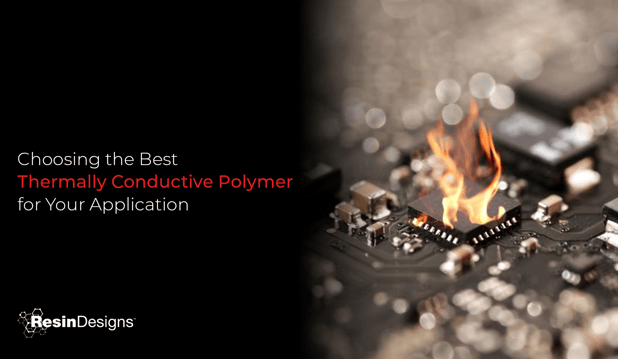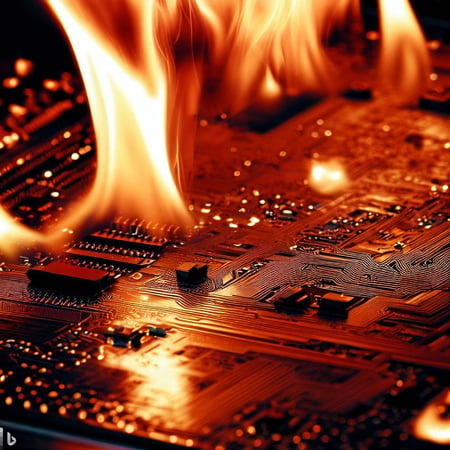
HEAT! It's public enemy number one for modern electronics and (especially) printed circuit boards (PCBs). If you've been in the electronics game for as long as we have, you're probably saying "Heat has always been an issue we've dealt with, so what's changed?" For one, more tightly packed, heat-generating board components are being designed. Component spacing and trace gaps continue to shrink like vacant land in Manhattan.
A second issue is that the electric vehicle (EV) and the supporting charging industry are posing new challenges for heat management. Consumer demand for lightning-fast charging times has resulted in higher voltage architectures that carry a large amount of electrical current.
The result is a lot of heat both externally in the charging stations themselves and internally to the EV automobile in onboard charging equipment and inverters.
What Are Thermally Conductive Polymers?
Thermally conductive polymers are adhesives, coatings, and films designed to transfer and conduct heat out and away from sensitive electronics. They serve to protect sensitive components such as integrated circuits and can substantially improve product durability and field failure rates. There are a number of different variations, including:
- Thermal Pads
- Phase Change Films
- Conductive Adhesives
- Thermal “Greases”
- Gap Fillers
- Encapsulation/Potting Polymers
For this discussion, we will focus on what factors need to be considered when choosing a material in the last category: encapsulation and potting polymers.
 Image Courtesy of Bing AI Image Creator
Image Courtesy of Bing AI Image Creator
Choosing the Right Thermally Conductive Polymer
You may decide your electronics are going to require heat dissipation using encapsulation. You went online or made some calls, but there seem to be an awful lot of options out there. Why are there so many? What questions should you even ask in the first place to choose the right one?
It seems that polymers can be designed with a wide range of processing viscosities, curing rates, hardness, and thermal conductivity. (Measured in the units Watts per meter degree Kelvin). They can be designed for complete encapsulation or potting of components or to act as an adhesive interface layer between the heat source and an attached heat sink.
Factors that are commonly considered important include:
- Material Considerations
- Thermal Conductivity Level (Low/Med/High)
- 1 or 2 Component
- Chemistry (Epoxy, Urethane, Silicone…)
- Hardness
- Exothermic Properties
- Chemical or Environmental Durability
- Regulatory Issues (UL, ROHS…)
- Processing Considerations
- Speed of Cure
- “Open” or Workability Time
- Viscosity
- Speed of Leveling
- Equipment Required
Bridging the Gap Between User Needs and Manufacturing Requirements
As all engineers and designers have experienced, it is a rare bird indeed when the commercial needs of the finished design line up perfectly with the product that processes in manufacturing most efficiently. It is of course most often the case that a hierarchy of end-user needs must be considered along with a hierarchy related to processing considerations. The goal is to meet all or at least most of the end-users' highest needs with a thermal management polymer that avoids the worst processing complications.
As an example, there is often a conflict between the need for the highest levels of thermal conductivity by customers and processing complications. In general higher conductivity is achieved through the use of higher and higher filler contents.
This high filler content comes with consequences, such as:
- Harder finished encapsulant
- May be more prone to cracking
- Heavy material can be a lift safety issue
- Risk of settling in process tanks and vessels
- Need for recirculation methods
- Need for inline, continuous mixing
- More complex cleaning processes
Bottom line, the delicate balance of product and process considerations is at times complex, and ranking the most important factors for both sides is a vital step.
The Thermosink Product Line
Chase Corporation, through our Resin Designs division, has designed a full range of silicone-based, two-component thermally conductive polymers branded as “Thermosink”. The chart below illustrates many of the properties discussed earlier such as a range of hardness values, viscosities, and cure times.
As a supplier of electronics protection polymers and coatings, Chase Corporation and its employees can help you with an unbiased approach to evaluating your application and process. We’ll show you how to maximize efficiency, minimize cost, and improve product reliability. Our outstanding manufacturing and technical support groups can provide your organization with reliable global supply, unmatched quality, and superior technical support.
Please contact us today to discuss your application.









